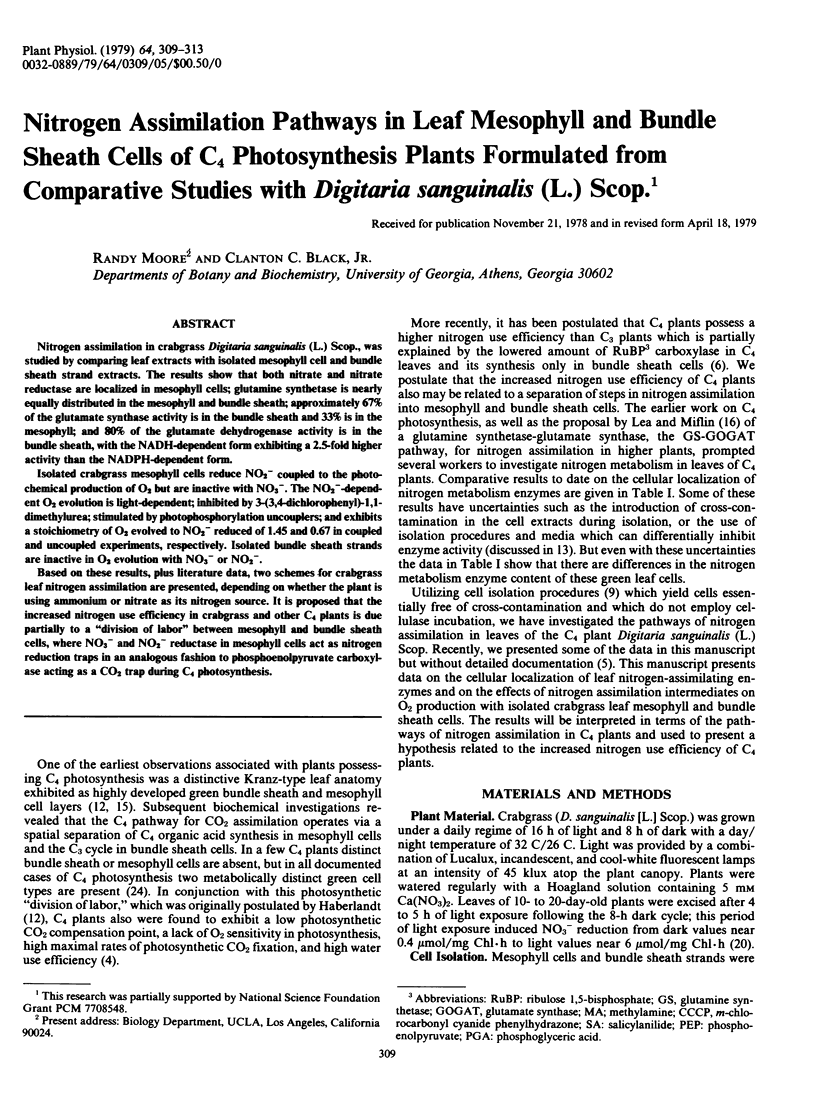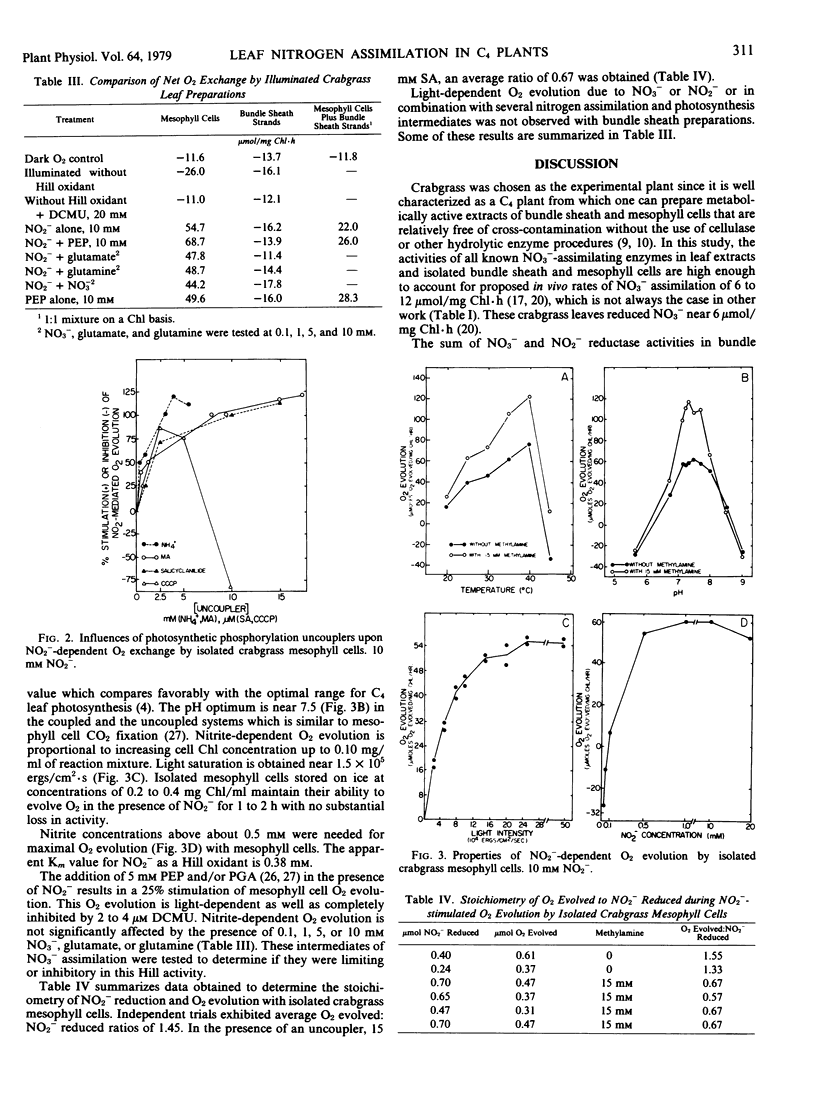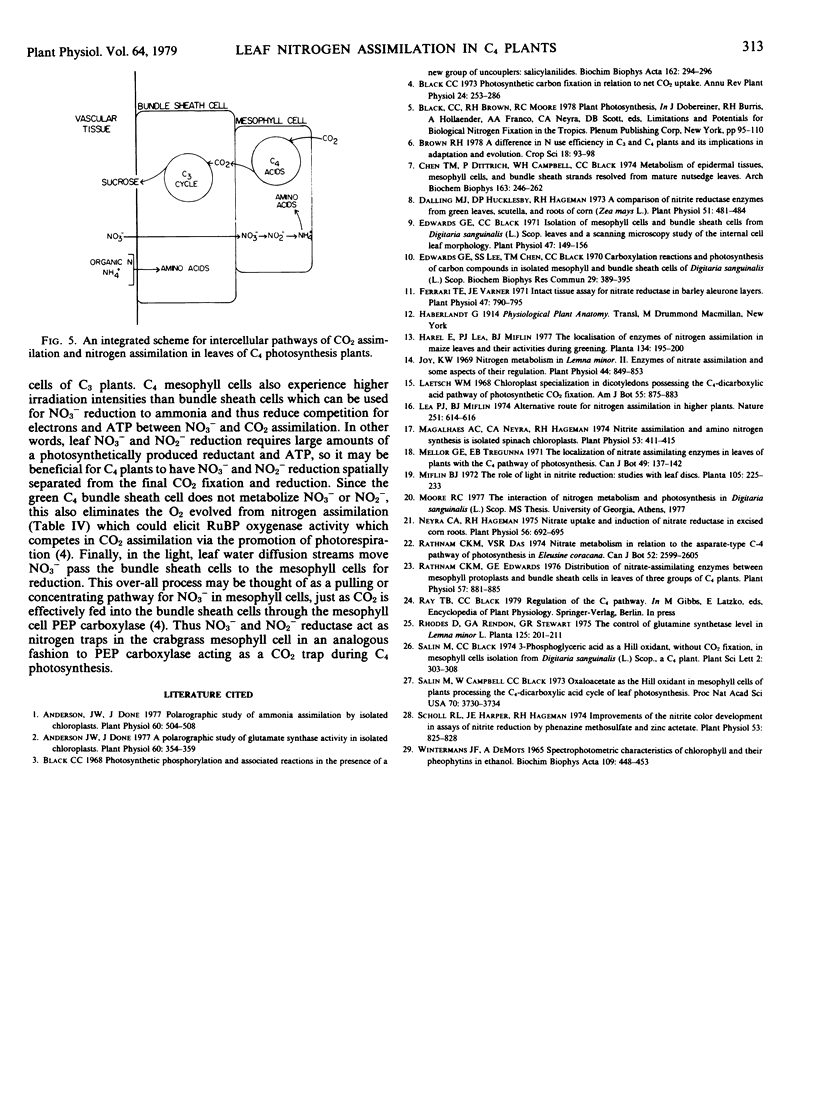Abstract
Nitrogen assimilation in crabgrass Digitaria sanguinalis (L.) Scop., was studied by comparing leaf extracts with isolated mesophyll cell and bundle sheath strand extracts. The results show that both nitrate and nitrate reductase are localized in mesophyll cells; glutamine synthetase is nearly equally distributed in the mesophyll and bundle sheath; approximately 67% of the glutamate synthase activity is in the bundle sheath and 33% is in the mesophyll; and 80% of the glutamate dehydrogenase activity is in the bundle sheath, with the NADH-dependent form exhibiting a 2.5-fold higher activity than the NADPH-dependent form.
Isolated crabgrass mesophyll cells reduce NO2− coupled to the photochemical production of O2 but are inactive with NO3−. The NO2− -dependent O2 evolution is light-dependent; inhibited by 3-(3,4-dichlorophenyl)-1,1-dimethylurea; stimulated by photophosphorylation uncouplers; and exhibits a stoichiometry of O2 evolved to NO2− reduced of 1.45 and 0.67 in coupled and uncoupled experiments, respectively. Isolated bundle sheath strands are inactive in O2 evolution with NO3− or NO2−.
Based on these results, plus literature data, two schemes for crabgrass leaf nitrogen assimilation are presented, depending on whether the plant is using ammonium or nitrate as its nitrogen source. It is proposed that the increased nitrogen use efficiency in crabgrass and other C4 plants is due partially to a “division of labor” between mesophyll and bundle sheath cells, where NO3− and NO2− reductase in mesophyll cells act as nitrogen reduction traps in an analogous fashion to phosphoenolpyruvate carboxylase acting as a CO2 trap during C4 photosynthesis.
Full text
PDF




Selected References
These references are in PubMed. This may not be the complete list of references from this article.
- Anderson J. W., Done J. A polarographic study of glutamate synthase activity in isolated chloroplasts. Plant Physiol. 1977 Sep;60(3):354–359. doi: 10.1104/pp.60.3.354. [DOI] [PMC free article] [PubMed] [Google Scholar]
- Anderson J. W., Done J. Polarographic study of ammonia assimilation by isolated chloroplasts. Plant Physiol. 1977 Oct;60(4):504–508. doi: 10.1104/pp.60.4.504. [DOI] [PMC free article] [PubMed] [Google Scholar]
- Chen T. M., Dittrich P., Campbell W. H., Black C. C. Metabolism of epidermal tissues, mesophyll cells, and bundle sheath strands resolved from mature nutsedge leaves. Arch Biochem Biophys. 1974 Jul;163(1):246–262. doi: 10.1016/0003-9861(74)90475-5. [DOI] [PubMed] [Google Scholar]
- Dalling M. J., Hucklesby D. P., Hageman R. H. A Comparison of Nitrite Reductase Enzymes from Green Leaves, Scutella, and Roots of Corn (Zea mays L.). Plant Physiol. 1973 Mar;51(3):481–484. doi: 10.1104/pp.51.3.481. [DOI] [PMC free article] [PubMed] [Google Scholar]
- Edwards G. E., Black C. C. Isolation of Mesophyll Cells and Bundle Sheath Cells from Digitaria sanguinalis (L.) Scop. Leaves and a Scanning Microscopy Study of the Internal Leaf Cell Morphology. Plant Physiol. 1971 Jan;47(1):149–156. doi: 10.1104/pp.47.1.149. [DOI] [PMC free article] [PubMed] [Google Scholar]
- Edwards G. E., Lee S. S., Chen T. M., Black C. C. Carboxylation reactions and photosynthesis of carbon compounds in isolated mesophyll and bundle sheath cells of Digitaria sanguinalis (L.) Scop. Biochem Biophys Res Commun. 1970 May 11;39(3):389–395. doi: 10.1016/0006-291x(70)90589-9. [DOI] [PubMed] [Google Scholar]
- Ferrari T. E., Varner J. E. Intact tissue assay for nitrite reductase in barley aleurone layers. Plant Physiol. 1971 Jun;47(6):790–794. doi: 10.1104/pp.47.6.790. [DOI] [PMC free article] [PubMed] [Google Scholar]
- Joy K. W. Nitrogen metabolis of Lemna minor. II. Enzymes of nitrate assimilation and some aspects of their regulation. Plant Physiol. 1969 Jun;44(6):849–853. doi: 10.1104/pp.44.6.849. [DOI] [PMC free article] [PubMed] [Google Scholar]
- Lea P. J., Miflin B. J. Alternative route for nitrogen assimilation in higher plants. Nature. 1974 Oct 18;251(5476):614–616. doi: 10.1038/251614a0. [DOI] [PubMed] [Google Scholar]
- Magalhaes A. C., Neyra C. A., Hageman R. H. Nitrite assimilation and amino nitrogen synthesis in isolated spinach chloroplasts. Plant Physiol. 1974 Mar;53(3):411–415. doi: 10.1104/pp.53.3.411. [DOI] [PMC free article] [PubMed] [Google Scholar]
- Neyra C. A., Hageman R. H. Nitrate uptake and induction of nitrate reductase in excised corn roots. Plant Physiol. 1975 Nov;56(5):692–695. doi: 10.1104/pp.56.5.692. [DOI] [PMC free article] [PubMed] [Google Scholar]
- Rathnam C. K., Edwards G. E. Distribution of Nitrate-assimilating Enzymes between Mesophyll Protoplasts and Bundle Sheath Cells in Leaves of Three Groups of C(4) Plants. Plant Physiol. 1976 Jun;57(6):881–885. doi: 10.1104/pp.57.6.881. [DOI] [PMC free article] [PubMed] [Google Scholar]
- Salin M. L., Campbell W. H., Black C. C. Oxaloacetate as the hill oxidant in mesophyll cells of plants possessing the c(4)-dicarboxylic Acid cycle of leaf photosynthesis. Proc Natl Acad Sci U S A. 1973 Dec;70(12 Pt 1-2):3730–3734. doi: 10.1073/pnas.70.12.3730. [DOI] [PMC free article] [PubMed] [Google Scholar]
- Scholl R. L., Harper J. E., Hageman R. H. Improvements of the nitrite color development in assays of nitrate reductase by phenazine methosulfate and zinc acetate. Plant Physiol. 1974 Jun;53(6):825–828. doi: 10.1104/pp.53.6.825. [DOI] [PMC free article] [PubMed] [Google Scholar]
- Wintermans J. F., de Mots A. Spectrophotometric characteristics of chlorophylls a and b and their pheophytins in ethanol. Biochim Biophys Acta. 1965 Nov 29;109(2):448–453. doi: 10.1016/0926-6585(65)90170-6. [DOI] [PubMed] [Google Scholar]


